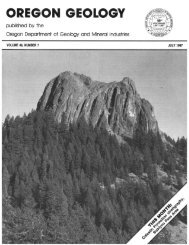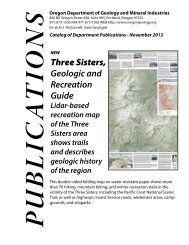The Ore Bin - Oregon Department of Geology and Mineral Industries
The Ore Bin - Oregon Department of Geology and Mineral Industries
The Ore Bin - Oregon Department of Geology and Mineral Industries
Create successful ePaper yourself
Turn your PDF publications into a flip-book with our unique Google optimized e-Paper software.
120 100 80 60 40 20<br />
Movement in mm per day<br />
Sherman<br />
Figure 5. Relative motion <strong>of</strong> ice-surface foliations in<br />
Sherman Crater, July 12, 1975 to August 1,1975.<br />
covered it with heavy snows, scientists continue to monitor the volcanic<br />
activity. <strong>The</strong> seismometer <strong>and</strong> temperature sensors continue to telemeter<br />
information from the crater rim, although the snow has buried the gas sensor,<br />
<strong>and</strong> the <strong>Ore</strong>gon Army National Guard continues to acquire infrared<br />
thermographs whenever flying conditions permit low-level overflights.<br />
Aerial photographs, taken from one <strong>of</strong> the Mohawks on November 15,<br />
show that despite heavy snowfall nearly 13,000 square meters <strong>of</strong> the crater<br />
area remain snow free. This figure confirms the estimates <strong>of</strong> heated ground<br />
area provided by the thermographic imagery during the summer months. Several<br />
minor flooding incidents on Boulder Creek earlier this fall have been<br />
attributed to snow avalanches temporarily blocking the exit <strong>of</strong> the meltwater<br />
from the crater through the East Breach <strong>of</strong> the rim. Sulfuric water<br />
in dangerous concentrations frequently wash es down the Bou Ider Creek<br />
drainage.<br />
31<br />
Peak<br />
to.









